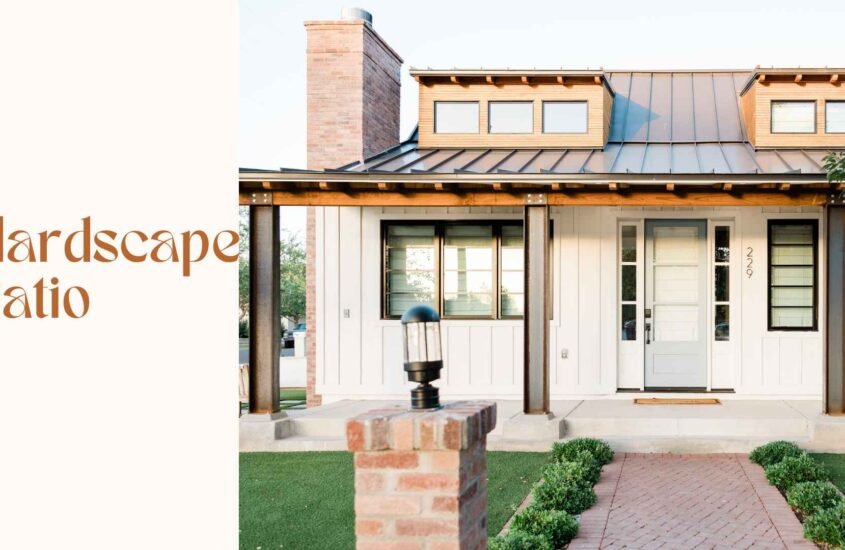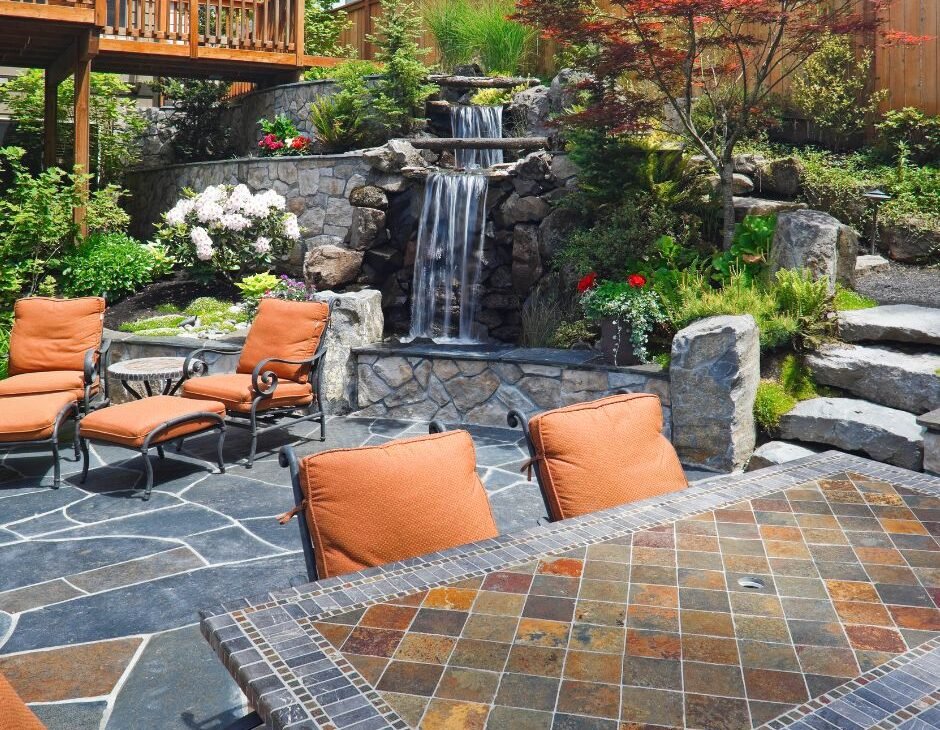Elevate Your Outdoor Living Space: Creating a Hardscape Patio

A hardscape patio refers to an outdoor living space that is constructed using durable and non-living materials, such as concrete, stone, brick, or pavers. It is designed to provide a functional and aesthetically pleasing area for various outdoor activities, such as dining, lounging, or entertaining.
Hardscape patios offer several advantages over traditional softscape elements like grass or plants. They are low-maintenance and require minimal upkeep compared to maintaining a lawn. Additionally, they can withstand different weather conditions, including heavy foot traffic, without easily wearing down or becoming damaged.
These patios are customizable and can be designed to complement the overall style and architecture of a home or outdoor environment. The materials used can be selected to match the existing features, colors, and textures, creating a cohesive and visually appealing outdoor elevate your outdoor living space.
Hardscape patios can be enhanced with various design elements, such as retaining walls, steps, built-in seating, fire pits, or outdoor kitchens. These features not only add functionality but also contribute to the overall ambiance and enjoyment of the patio.
In summary, a hardscape patio is a durable, low-maintenance outdoor space constructed using non-living materials. It offers versatility, customization, and aesthetic appeal, making it an excellent option for creating an inviting and functional area for outdoor relaxation and entertainment.
Hardscape Patio: Crafting Your Outdoor Sanctuary
A hardscape patio serves as the cornerstone of your outdoor sanctuary, providing a solid foundation that seamlessly complements the natural elements of your landscape. Let’s delve into the key facets of hardscape patios:
Durability: Standing the Test of Time
One of the primary advantages of hardscape patios lies in their exceptional durability. Unlike traditional wooden best decks that necessitate regular maintenance and are susceptible to weathering over time, hardscape patios are built to endure. Constructed with robust materials such as concrete, stone, or pavers, these patios are resilient against wear and tear, making them ideal for high-traffic areas and various weather conditions. Whether you’re hosting vibrant gatherings or seeking solace in your outdoor sanctuary, a hardscape patio will remain steadfast for years to come.
Design Versatility: Unleashing Creativity
Hardscape patios offer boundless design possibilities, allowing you to infuse your outdoor space with your own unique flair and style. From rustic charm to sleek modernity, there exists a hardscape patio design to cater to every preference. Let your creative spirit soar as you choose from an array of materials, shapes, colors, and patterns. Whether you gravitate towards the timeless elegance of natural stone or the contemporary allure of concrete pavers, your hardscape patio can be tailored to reflect your individual aesthetic.
Enhancing Curb Appeal: A Visual Delight
A well-crafted hardscape patio serves as a captivating centerpiece, augmenting the overall curb appeal of your property. Seamlessly integrating with your landscape, it creates an aesthetically pleasing outdoor paradise. Imagine a cozy fire pit nestled amidst a beautifully paved patio, beckoning guests to gather and share stories beneath the starlit sky. By incorporating carefully selected hardscape elements like retaining walls, pathways, and seating areas, your patio will transform into an enchanting extension of your home, leaving an indelible impression on all who visit.
Low Maintenance: More Time for Enjoyment
Bid farewell to laborious upkeep and relish in more leisurely moments with hardscape patios. Unlike traditional grass lawns that demand regular mowing, watering, and fertilizing, hardscape patios require minimal maintenance. With a simple sweep or occasional pressure wash, you can keep your patio looking pristine throughout the seasons. Spend less time tending to your outdoor space and more time savoring its splendor, creating unforgettable memories with your cherished ones.
Selecting the Right Materials Elevate Your Outdoor Living Space
Choosing the right materials is crucial when designing a hardscape patio.Here are some important factors to consider:
Durability: Opt for materials that can withstand the elements and heavy foot traffic. Look for hardscape materials like natural stone, concrete pavers, or composite decking that have a proven track record for durability.
Aesthetics: Consider the desired look and style of your patio. Different materials offer various colors, textures, and patterns. Natural stone provides a timeless and organic appearance, while concrete pavers offer versatility in terms of shape and design possibilities.
Maintenance: Evaluate the maintenance requirements of different materials. Some materials may require periodic sealing, cleaning, or repair. Choose materials that align with your desired level of maintenance commitment.
Climate Compatibility: Take into account your local climate. Certain materials may be more suitable for specific climates. For example, porous materials like gravel or permeable pavers are beneficial in areas with heavy rainfall as they promote water drainage.
Budget: Determine your budget for the project. Some materials, such as high-end natural stone, can be more expensive than alternatives like concrete or composite materials. Consider the long-term value and potential return on investment when evaluating the cost.
Compatibility with Surroundings: Consider how the chosen materials will harmonize with the existing landscape, architecture, and surroundings. Select materials that complement the overall aesthetic and blend well with the existing elements.
By carefully considering these factors, you can select the right materials for your hardscape patio that meet your durability, aesthetic, maintenance, climate, budget, and compatibility requirements.
How long does a hardscape patio typically last?
The lifespan of a hardscape patio can vary depending on several factors, but with proper installation and maintenance, it can typically last for several decades. On average, a well-built and well-maintained hardscape patio can last between 20 to 30 years. However, some hardscape materials, such as concrete and natural stone, have the potential to last even longer, possibly exceeding 50 years or more.
Regular maintenance, including cleaning, sealing, and addressing any repairs promptly, can significantly extend the lifespan of a hardscape patio. Additionally, factors such as climate, usage, and the quality of installation play a role in determining how long the patio will last. It’s always a good idea to consult with professionals and follow best practices to ensure the longevity of your hardscape patio.
Can hardscape patios be customized to suit different styles and preferences?
Yes, hardscape patios can be customized to suit different styles and preferences. Hardscape materials, such as concrete, pavers, and natural stone, offer a wide range of options for customization in terms of texture, color, and pattern. Concrete can be stamped, stained, or colored to mimic various natural stones or create custom designs. Pavers come in different shapes, sizes, and colors, allowing for intricate patterns and designs. Natural stone offers a natural and timeless look with its diverse range of colors and textures.
Additionally, hardscape patios can be designed to incorporate different features, such as seating areas, fire pits, water features, and lighting, to create a unique and personalized outdoor space. The design can also be tailored to complement the architecture and landscaping of the surrounding area, as well as suit the homeowner’s lifestyle and preferences. With the help of professionals and careful planning, hardscape patios can be customized to meet a variety of styles and needs.
Are hardscape patios environmentally friendly?
Hardscape patios can vary in their environmental friendliness depending on factors such as materials, permeability, water management, native plants, and maintenance practices. Choosing sustainable materials like natural stone or recycled concrete pavers can reduce the carbon footprint. Using permeable hardscape materials and incorporating water management techniques can minimize stormwater runoff. Integrating native plants supports local ecosystems and reduces water usage. Implementing sustainable maintenance practices, such as using eco-friendly cleaners and repairing any damage promptly, helps prolong the lifespan of the patio. By considering these factors, hardscape patios can be designed and maintained with a reduced environmental impact.
Can I install a hardscape patio myself, or should I hire a professional?
Installing a hardscape patio requires careful consideration before deciding whether to tackle the project yourself or hire a professional. Here are some important factors to consider:
Expertise and Experience: Assess your own construction and hardscaping skills. If you have prior experience and feel confident in your abilities, you may consider DIY installation. However, a thorough understanding of the installation process and the specific requirements of your chosen hardscape materials is crucial.
Time and Effort: Installing a hardscape patio demands a significant investment of time and physical exertion. Evaluate the size of the project and whether you have sufficient time and energy to commit to the entire installation process, which can include heavy lifting, excavation, and precise leveling.
Complexity of the Design: Consider the complexity of your desired patio design. Basic designs with straightforward materials may be suitable for DIY installation, while intricate patterns or complex features might necessitate professional expertise to ensure proper installation and desired results.
Tools and Equipment: Determine if you have access to the necessary tools and equipment. Some specialized tools, like compactors or wet saws, may be required for proper installation. Assess whether you own the requisite tools or if it would be more cost-effective to hire a professional who already possesses them.
Long-Term Results: Think about the long-term implications of the installation. Professionally installed hardscape patios tend to exhibit better durability, structural integrity, and compliance with local building codes. Professionals are well-versed in drainage considerations, site preparation, and industry best practices.
In summary, while DIY installation is feasible for individuals with the requisite skills and resources, hiring a professional is often advisable. Professionals bring expertise, efficiency, and enhanced quality, particularly for complex designs or individuals lacking hardscaping experience. By opting for professional assistance, you can save time, effort, and potential issues in the long run.
Adding Personal Touches and Accessories Creating Built-in Seating Materials Elevate Your Outdoor Living Space
Adding personal touches and accessories to your hardscape patio can transform it into a comfortable and elevate your outdoor living space. Consider incorporating outdoor furniture for seating, lighting to extend usability into the evening, and shade solutions like umbrellas or pergolas. An outdoor kitchen or barbecue area can enhance your cooking and entertaining experience. Fire features create warmth and ambiance, while decorative elements like plants, artwork, or water features add visual interest. Don’t forget about outdoor entertainment options such as sound systems or outdoor movie screens. By personalizing your patio with these touches, you can create a space that reflects your style and enhances your outdoor living experience.

Enhancing with Steps and Stairs
Enhancing your hardscape patio with steps and stairs adds both functional and visual appeal. Choose a design that complements your patio’s overall aesthetic, using materials like natural stone or concrete pavers. Consider the size and placement of the steps to ensure a comfortable and safe transition between different levels. Prioritize safety by using slip-resistant materials and installing handrails if necessary. Adding lighting to steps and stairs improves visibility and enhances the ambiance of your patio. By incorporating steps and stairs, you can create an elegant and practical connection between different areas of your hardscape patio.
Creating Built-in Seating Materials Elevate Your Outdoor Living Space
Creating built-in seating in your hardscape patio is a practical and stylish way to maximize comfort and enhance the functionality of your outdoor space. Here are some key points to consider when incorporating built-in seating:
Design and Placement: Determine the best location for the built-in seating based on the layout of your patio and the desired functionality. Consider factors such as sunlight, views, and the flow of foot traffic. Integrate the seating seamlessly into the patio design to ensure a cohesive and integrated look.
Materials: Choose materials that are durable, weather-resistant, and suitable for outdoor use. Common options include stone, concrete, wood, or composite materials. Select materials that complement the overall aesthetic of your patio and match well with other hardscape features.
Size and Shape: Consider the available elevate your outdoor living space and the number of people you expect to accommodate. Determine the appropriate size and shape of the built-in seating to ensure comfortable seating for your intended use. Consider incorporating curves or angles to create visual interest and accommodate the flow of the patio design.
Comfort and Cushions: Enhance the comfort of the built-in seating by adding cushions or upholstery. Choose outdoor-grade fabrics that are resistant to fading and moisture. Consider incorporating cushions with removable covers for easy cleaning and maintenance.
Storage and Functionality: Explore options for built-in seating with added functionality, such as storage compartments or built-in planters. These features can provide additional practicality and help declutter your outdoor space.
Integration with Surroundings: Ensure that the built-in seating integrates well with the surrounding landscape and hardscape elements. Consider incorporating matching or complementary materials, colors, and textures to create a harmonious and visually appealing patio design.
comfortable and inviting space
By creating built-in seating in your hardscape patio, you can provide a comfortable and inviting space for relaxation, socializing, and enjoying the outdoors. Thoughtful design and material choices will help maximize the functionality and aesthetic appeal of your built-in seating area.
LightingElevate Your Outdoor Living Space
Proper lighting can significantly enhance your outdoor living space, creating a warm and inviting ambiance while also increasing safety and functionality. By carefully selecting and strategically placing a variety of outdoor lighting fixtures. You can transform your space into a beautiful and enchanting retreat. Ambient lighting sets the overall mood, task lighting ensures functionality for activities like cooking or reading, and accent lighting highlights architectural features and landscaping. Incorporating energy-efficient options and utilizing a mix of fixtures and string lights can add depth and visual interest. By paying attention to lighting, you can enjoy your outdoor space day and night. And create a welcoming environment for entertaining or simply relaxing under the stars.
Planning and Design Elevate Your Outdoor Living Space
Planning and design play crucial roles in elevating your outdoor living space. Before embarking on any enhancements, it’s essential to assess the available space and its layout. Determine the purpose and functionality you desire for the area, whether it’s for entertaining, relaxation, or both. Incorporate desired features such as seating, dining areas, kitchens, or fire pits to meet your specific needs.
Consider the local climate and weather conditions when designing your outdoor space. Opt for materials that can withstand the elements and choose plants that thrive in your region. Creating a cohesive and visually appealing landscape design is important. Incorporate elements of hardscaping, such as pathways or retaining walls, to complement the natural surroundings.
Additionally, integrating appropriate outdoor furniture and accessories is crucial. Select durable and weather-resistant furniture that can withstand exposure to sun and rain. Comfortable seating options and functional tables or benches enhance the usability of the space. Add accessories like pillows, cushions, and umbrellas to create a cozy and inviting atmosphere.
Furthermore, lighting is key to elevating your outdoor living space. Utilize a mix of ambient, task, and accent lighting to set the mood, enhance functionality, and highlight key features. Install outdoor fixtures, string lights, and energy-efficient lighting options to create a welcoming ambiance and extend the usability of the space into the evening.
By carefully planning and designing your elevate your outdoor living space, taking into account layout. Functionality, landscaping, furniture, accessories, and lighting, you can create an elevated and enjoyable environment that reflects your personal style and enhances your elevate your outdoor living space experience.
Conclusion
A hardscape patio is not only a visually stunning addition to your outdoor space. But also a durable and functional investment that can transform your backyard into a remarkable oasis. With their versatility, low maintenance requirements, and ability to enhance curb appeal, hardscape patios provide endless possibilities for creating an inviting and long-lasting outdoor retreat. Whether you’re hosting lively gatherings, relaxing in solitude, or simply enjoying the beauty of nature. A thoughtfully designed hardscape patio will be the centerpiece of your outdoor paradise









